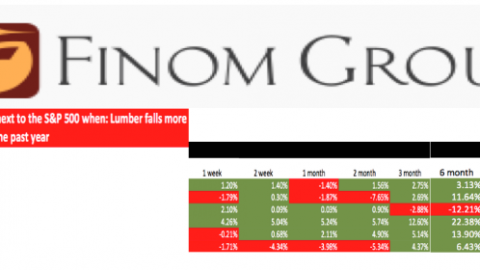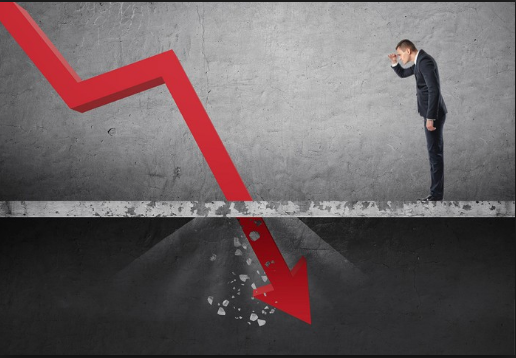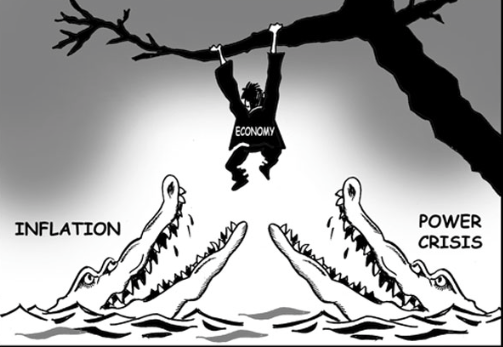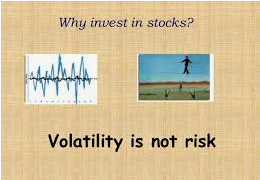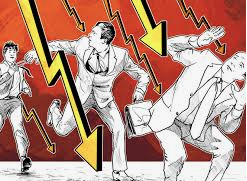The present day economic and equity market situation is one concerning “when, not if“. It’s the when that we tend to pontificate and concern ourselves with the greatest. What do I mean; what are we talking about you might be asking yourself. The following S&P 500 chart speaks to the “when”. And when does the precipitous decline resemble that which preceded the decline?
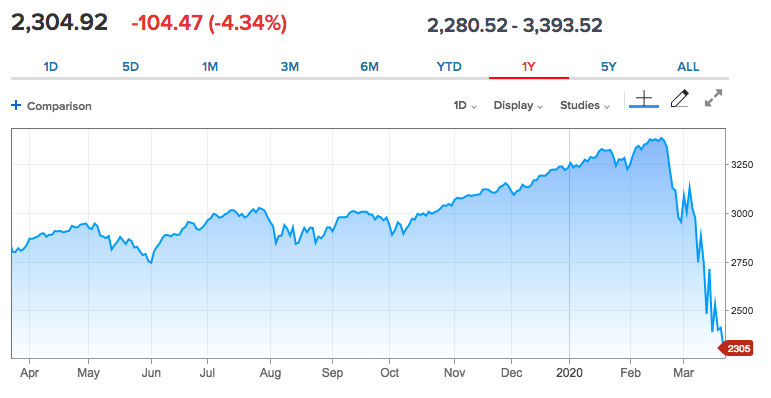
The fun and fruitful part of investing and/or trading is that which led up to the sudden decline. The painful and arduous part of investing and/or trading is the decline. The funny part of the aforementioned decline is that most were hopeful for an opportunity to add money into a pullback. The same folks are now too fearful of the present day market conditions and even questioning “if” the market will do as it has always done throughout history. The S&P 500’s history is depicted below, but for the sake of clarity: The market goes from the lower left-hand corner to the upper right-hand corner over time. It rises in value with time.
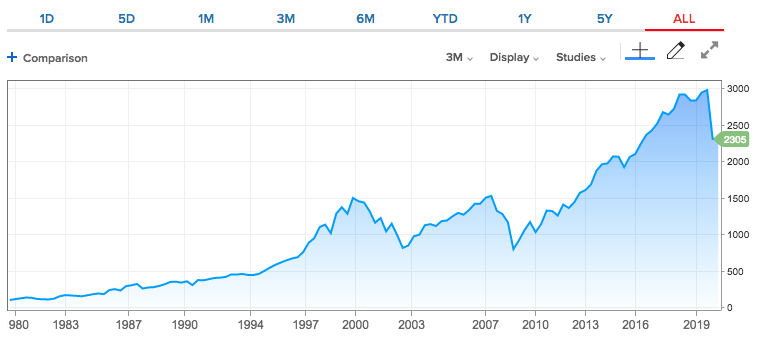
Viewed from this perspective, it’s still a rather sharp and rapid decline, the most rapid in history in fact (peak-bear market territory 16 days) that has presented itself. Nonetheless and unless you think the world is coming to an end and humanity cannot overcome COVID-19 the way it overcame the Great Depression, World War II, the Oil Embargo & Nixon era, Vietnam, Black Monday, Dotcom Crash, SARS, 9-11, Great Financial Crisis, European Debt Crisis, Yuan Devaluation/China Hard Landing Fear and Fed Tightening Cycle, you might rationalize the present time period for the usual long-term opportunity it breeds.
I certainly recognize it’s difficult to see the forest for the trees at the moment, especially when the mantra of the day is to stay indoors and maintain social distancing protocols. Having said that, none of this shouldn’t exonerate the truisms of mankind’s ingenuity, fervor of spirit and our abilities to “always find a way”.
Since December 26, 2017 (the day after Christmas), Finom Group has been delivering weekly Research Reports and our thoughts on the market and economy daily. We pick up every rock and turn over every leaf in the world of the financial media to discover and uncover analysts thoughts and ideas in order to deliver a well-rounded weekly Research Report that ultimately delivers a consensus viewpoint. In doing so, and with almost 50 years of combined research and portfolio management experience, we understand there are going to be some winners and losers that develop from the depths of the current health and economic crisis.
Finom Group also recognizes the value in building resources. Unfortunately, many individual traders/investors don’t feel the same way or they simply lack the experience of engaging resources and becoming… resourced. No, many investors simply do the whole “go it alone” thing. Thinking and believing they “can do this” and with the frequently hyperbolized hatred for analyst who fall under the scrutiny of “analysts are always wrong” characterization. At Finom Group, we hate to say it, but the crowd isn’t far off with their regarding for the analyst community. Nonetheless, we must not discount that analysts are no different than you and I. They are reading the tea leaves so to speak, and given their experience and acumen delivering an outlook and or price target. Even so, we should always recognize that 2 heads are better than one and if for nothing more than feedback and/or playing the role of “devil’s advocate” for any capital allocation decision-making. This raises our previous point on resource building.
“We pick up every rock and turn over every leaf in the world of the financial media to discover and uncover analysts thoughts and ideas in order to deliver a well-rounded weekly Research Report that ultimately delivers a consensus viewpoint.”
Over my 20+ years as an investor, and sell side analyst in my own right, I’ve networked and studied other analysts. There are few that I hold in high regard, but I certainly respect their works. Their works can and should be arduous to ascertain the most probable outcomes delivered to firm’s clients. Analysts have an extremely difficult job! I can’t stress this enough and speaking from someone who was formerly in the “hot seat” for 4 years as a consumer packaged goods analyst for Capital Ladder Advisory Group.
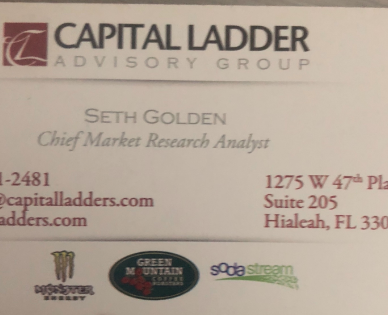
That was my former business card. I remember those days well. I was referred to as the “axe” in each of these stocks. I was the most hated perosn amongst the Monster Beverage and Green Mountain investor crowd. I was bearish for certain periods during my coverage period and found to be most hated by the CEO of GMCR, Brian Kelley. It was rumored that Brian had a picture of me on the door to his office, for which he would throw darts. It was rumored, until in 2016, the coffee maker giant hired me as an outside consultant and I found the rumor to be true.
If there was a big client that wanted the most accurate and proven forecast for these stocks and the others in my coverage space, Capital Ladder Advisory Group’s phone rang. I was the first, back in 2012 to suggest a big plunge ahead in Monster Beverage. I was the ONLY to warn on the business prospects for Keurig Green Mountain from 2014-2015 and with a 12-month price target of $45, while the share price was well over $100 at the time and Keybanc offered a $150 price target. And when SodaStream IPOd, I was the most bullish on the firm’s long-term prospects, while moving to the sidelines in 2015 after recognizing some time was needed to streamline business operations as it’s woeful competitors were also crumbling. Again, analysts have a tough job. They don’t always get it right, but they always deliver their best and most objective puts and takes in my opinion.
Given the unique situation investors are presented with today, we strongly encourage our free, Basic Membership level readers upgrade to our Contributor Membership level and receive our Weekly SOTM video and Research Report. Truth be told, our market forecasts haven’t been wrong since our genesis, but even more honestly speaking our pullback calls from January of this year didn’t suggest something of the current magnitude. Remember, analysts have a tough job and when a so called “black swan” event arrives, nobody’s right and everyone experiences pain. With that, we offer some notes within this weekend’s Research Report before picking some analysts and market participants that we think should become part of your resource base.
This Weekend’s Research Report Notes
“The previous 3 bear markets that avoided a recession recovered the gains in 3 months, 4 months, and 4 months after the ultimate bear lows were made. Put it altogether and we suggest investors and traders alike consider the following going forward:
- The current social, economic and market crisis will only last but for so long. This is going to register as the same blip in otherwise elongated secular bull markets. We will be looking at the current crisis in the rear view mirror in a matter of months if not weeks, according to our analysis of bear markets and economic shocks which are followed by fiscal and monetary stimulus.
- Maintain a grounded game plan for the weeks ahead and review your game plan and process daily.
- Remain disciplined especially when markets are expressing dislocation, illiquidity and extreme volatility.
- Until fiscal policy is delivered with a vote passage, markets remain skeptical and without support. Such uncertainty demands patience on the part of investor allocation decision making.
- How much worse can it get? Truth be told; nobody knows. But the market continues to price in the worse case scenario as uncertainty is the market’s enemy.
- Know that this is not forever, we are not reverting to the dark ages and all aspects of human life will overcome in the not too distant future.
- Cash is your friend! Do not worry about missing a 5-10% rally, but rather focus on seeking greater certainty as your guide for allocating capital. Where certainty is found, the market will trend. Right now, the market is certain of an economic and earnings contraction and trending lower. It has been pricing this in, it happened. Going forward, the market will seek to find a bottom in these macro-elements and eventually the return to growth. When it finds that certainty, it will bottom and begin to trend higher.
More Notes
“In 2008, while the VIX peaked in October, the market continued to churn and ultimately found its final bottom in March of 2009 or nearly 6 months later. Circumstances again, were different in 2008 as Lehman Brothers was allowed to go bankrupt and before the Federal Reserve began to take the situation unfolding more seriously. The present day crisis is one that the Fed has already gotten out in front of from a monetary policy perspective, and aiding in supporting financial conditions. While financial conditions have tightened, the Fed can only do so much without the assistance of fiscal policy initiatives.
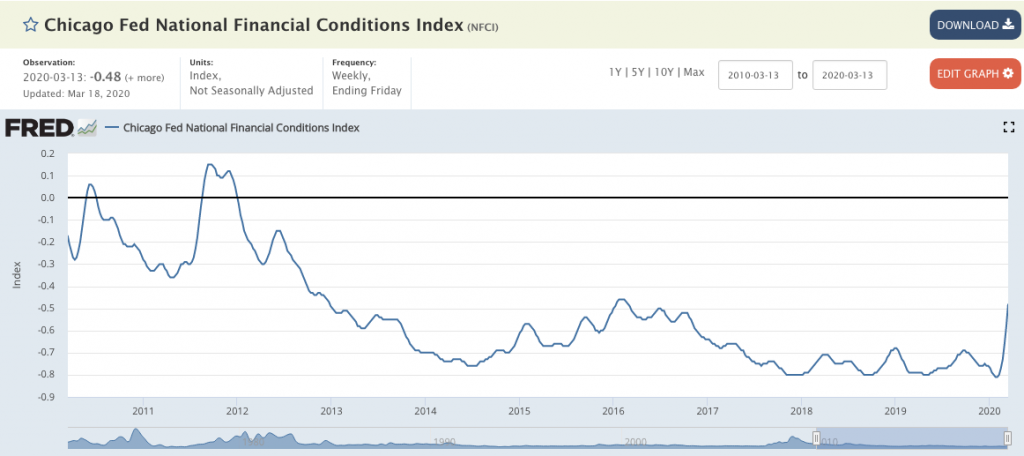
As shown in the chart of financial conditions above, we depict tighter financial conditions, but still not yet even close to those experienced during the technical bear market of 2011. This does not exonerate that such conditions won’t be found in the weeks or months ahead, but it does suggest that the Fed has been effective in its present day efforts to ease credit market issues and ensure the flow of funding operations. The Fed needs a partner going forward… and quickly.“
Still More Notes
“What will come in the week ahead is extremely difficult to predict and given the heightened state of uncertainty in the economy and market. The S&P 500 failed to make a stand last week, as it closed well below the December 2018 lows and at its lows of the year. While indeed the VIX failed to climb on Friday even with the S&P 500 falling some 4.3%, and such a VIX decoupling does usually serve to signal a near-term bottom for the S&P 500 , we would exercise caution on using history as our guide. Remember, the VIX has remained extremely high for more than a week and recently had an all-time closing high above 82 this past week.
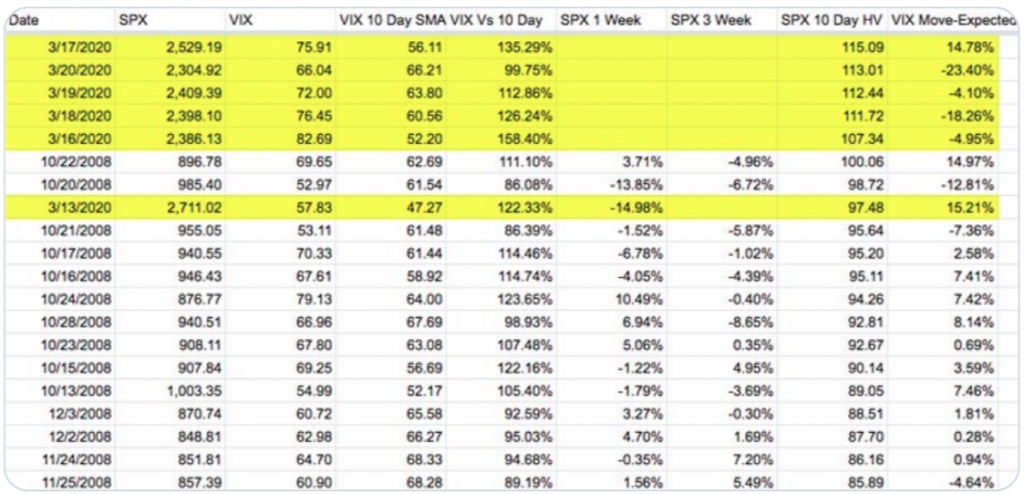
Extremes are often met with some mean reversion and independence of their market correlation/s. Don’t be the trader who relies on history as a guide in the current market cycle, beyond the fact that we will always overcome the issues of the day and in all matters. Be the trader who finds confirmation in market trend and price firstly.“
Wrapping Up Our Snippets
“In a bear market, there will be all sorts of chaos and panic-driven stories every day for what could be weeks on end. We do know that with all of the unknowns that will require some sort of speculation, folks will start extrapolating the worst case scenario from these stories and they will always lean toward the most negative conclusions. That is how the human mind tends to work. The permabears who have been going around for the better part of the bull market citing all of the reasons why the market was going to crash, never mentioned a virus or a crude oil war did they. They incorrectly cited everything else, but will make sure they let us know they “called it”. Wrong for years and now claiming they “Knew it”, the height of lunacy. Don’t find yourself, and because of a bear market, thinking that all of a sudden these same permabears who have been wrong for 11 years are all of a sudden smarter today than they were through the 11-year bull market. Intelligence isn’t achieved in just 2 months; the mind doesn’t tend to work that way.
We encourage our readers to be responsible in all aspects of daily life as we travel through the current economic environment and aim to overcome the COVID-19 saga. Please be safe out there if traveling and be safe in a turbulent market environment that is void of any certainties presently. Now is not the time for reckless behaviors in any shape or form.“
We hope some of these notes from within our 40+ page Research Report help you to identify whether or not you feel upgrading your membership to our Contributor Membership level program is worthwhile, as there is a great deal to discover and find yourself greatly resourced. With a focus on resources this weekend, I don’t think I’ve seen a more honest offering from one of my favored resources, in a tweet this weekend.

Tony Dwyer is the chief market strategist for Canaccord Genuity. I’ve followed Tony’s works for several years now, and we’ve found it quite reliable, unbiased and base on historical precedence and an honest depiction of the current economic and market environment. In Tony’s tweet positioned above, I can appreciate the honest from a strategist/analyst when recognizing this is a very different set of circumstances we are all contending with, in the market and in life. Moreover, what I can also appreciate is the recognition of human behavior in Tony’s tweet. Simply put, we are very much creatures of habit and the market is a reliable expression of human behaviors over time. In Tony’s recent notes he discussed the element of human behavior with the following 3 points emphasized and as it relates to markets/investing:
- Panic – happens toward the end of the initial crash like what happened in Aug. 2011 and this week. The 63-day correlation of the individual S&P 500 (SPX) components to the Index itself saw a 2-standard-deviation event, which only happens in a crash.
- Relief – develops after the crash with a reflex rally as investors are simply glad it stopped going down.
- Demoralization – happens when the market tests the panic low and even marginally breaks it, as seen in the drop in early Oct. 2011. The good news is that this is quickly followed by a significant liftoff in equities.
“But what about algorithms?” Ahhhhh, good question. The best way I can answer this is to ask the question, “Who do you think is providing the code and logic for these algorithms, still humans!” We fully recognize the evolution of markets and how algorithmic trading plagues market liquidity at every corner, but the human element is only minimized in the algo-equation, it isn’t deemed eliminated. To put a final pin in this segment, we would strongly encourage our members to utilize Tony Dwyer as a resource of sorts going forward and you can follow him on Twitter here.
Another one of our favored fund managers and market strategists is Andrew Thrasher, who also issues the Thrasher Analytics Reports to clients. Andrew serve as a Portfolio Manager for an RIA, the Financial Enhancement Group, in central Indiana. He helps to serve families across the state as well as the country, helping them plan for and invest for the retirement and future financial goals. In this role, it is his responsibility to work with his firm’s CIO, Adam Harter, CFA in managing and trading the investment models used for client assets.
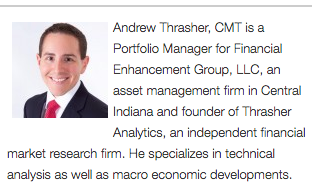
In recent years, I’ve found Andrew’s market studies and notes to be well-rounded, disciplined and established by way of fostering routines. I can’t stress to you enough how foundational having daily/weekly routines are when engaging the markets as a fund manager, even at the individual level. In following Andrew’s works over the last 3 years, I’ve found his volatility-complex knowledge also highly beneficial. Without giving away too much of his recent reporting, I will offer the following as it very much mirrors my dialogue with Premium Members this past week. In our Trading Room, I discussed with members how it would be unlikely for the market to find a sustainable bottom with 10-day realized VOL and the VIX (30-day implied volatility) remaining stubbornly elevated.
“Volatility needs to calm down. We need to stop having circuit breakers triggered on both down and up days. When I say volatility, I don’t mean the VIX which is an expectation of future volatility, but the literal ups and downs being experienced in equities presently. While strength in equities is welcomed, the kind of moves higher we’re occasionally seeing right now aren’t characteristics of a healthy market. Some of the best days often follow the worst. I want to see large swings diminish.“
My list of useful and insightful resources could go on and on, but who has the time? With that forgiveness of sorts being asked, I’ll leave you with one final resource who comes to markets with a technical-based approach. He’s kind of an arse, politely put, but don’t let personality cloud one’s assessment of his expertise. J.C. Parets has been making an impression on me over the last year. In earnest, he’s extremely timely with his articles and has offered very prescient market calls, based on my followership since late 2018 or so. One of his most recent notes discusses a truism of markets, when trending in either direction.

“Have you noticed how stocks keep making lower lows and lower highs? We call those downtrends.
There’s an important reason why I bring this up. There is a much higher likelihood for markets to continue in the direction they’re heading in, than for them to just reverse course and start to move in the opposite direction. This is true for both uptrends and downtrends.“
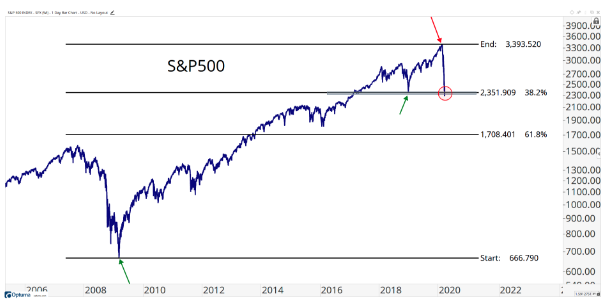
So there you have it folks! We hope you found this offering on a Sunday, timely, resourceful and joining us for future discussions and insights into all things concerning the macro and micro environments. Be well and… I guess I shouldn’t say “be in touch”, at least for the time being!


